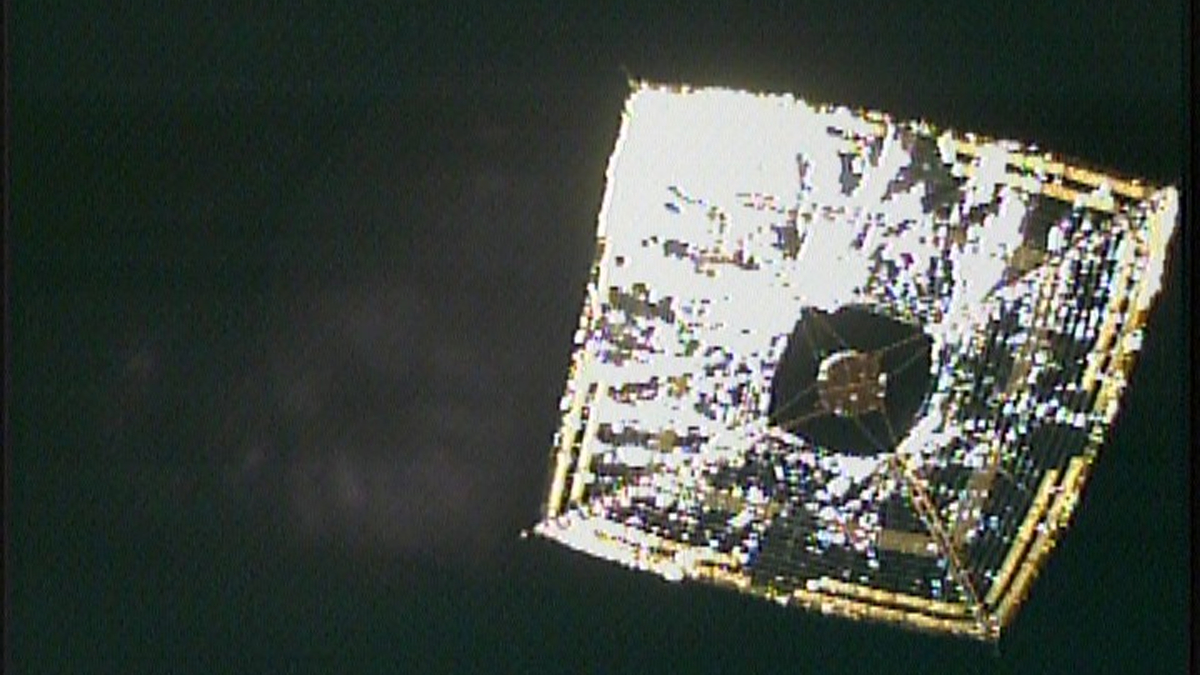If there's life on Europa, solar sails could help us find it
"As humanity continues to expand space exploration, chemical propulsion will hit its limit."

Solar sails, which harness sunlight as sailboats harness the wind, could be affordable probes in the search for alien life on at least two icy moons in our solar system — Jupiter's Europa and Saturn's Enceladus, a new study suggests.
Unlike conventional rockets, which require lots of fuel to generate thrust, solar sails leverage the subtle push of sunlight to cruise through space. They are propelled when photons, or particles of light, strike them and impart their momentum. This way, "the light itself functions like the wind," Manasvi Lingam, an astrobiologist at the Florida Institute of Technology and the lead author of the new paper, told Space.com.
The push given by light particles is slight but continuous, meaning they can eventually accelerate a solar-sailing probe to speeds unattainable with conventional rockets, which are heavier thanks to the propellant they carry — a problem that increases with the size of the spacecraft. Solar sails, however, gain momentum from the sunlight they capture, so "they don't have to carry their fuel onboard," said Lingam.
Related: What is a solar sail?
Given sails' reliance on sunlight, their use could be ultimately limited to the inner solar system, where sunlight is abundant. However, at least in theory, a network of tiny lasers here on Earth or placed in orbit at one of the Lagrange points could add further momentum and eventually propel solar sails to the outer solar system, said Lingam.
For instance, in the new study, his team estimates that a 220-pound (100 kilograms) solar sail could reach Jupiter's moon Europa in just one to four years and Saturn's moon Enceladus in three to six years.
Both worlds are thought to harbor a global salty ocean underneath their ice-covered surfaces, making them tantalizing targets in the search for alien life in our solar system. Enceladus is known to blast watery geysers from its south polar region, and hints of plumes have been spotted at Europa as well.
Breaking space news, the latest updates on rocket launches, skywatching events and more!
Sampling such plumes, which may host intriguing biomolecules like amino acids, would allow scientists to study the makeup of the moons' oceans without needing to land a spacecraft and drill through thick ice.
When performing flybys through these plumes, high spacecraft speeds would lead to the particles striking a probe relatively hard, meaning "the molecules can be destroyed, and that, in turn, can destroy any signs of putative life," said Lingam. To avoid that, a solar sailing mission should be capable of reducing its speed to the minimum encounter velocity of about 6 kilometers per second (about 3.7 miles per second), Lingam and his team report in their new paper, published Feb. 28 in the journal Acta Astronautica.
This particular space technology is not unheard of. For example, LightSail 2, a crowdfunded, shoebox-sized spacecraft operated by the nonprofit Planetary Society, launched to Earth orbit in 2019. By November 2022, LightSail 2 had achieved 18,000 orbits and traveled roughly 5 million miles (8 million kilometers) during its three years in orbit — three times longer than its original design lifetime.
Solar sails have worked farther from home, too: Japan's Ikaros spacecraft demonstrated solar-sailing technology in deep space back in 2010.
Some scientists think solar sails could even propel humanity's first interstellar missions. For instance, the $100 million Breakthrough Starshot Initiative, announced in 2016, aims to build a swarm of lightweight microchip-sized spacecraft and send them to Alpha Centauri, the nearest star system to Earth. Propelled by lasers at 20% the speed of light, these light sails could reach Alpha Centauri in just 20 years—within our lifetimes.
After 65 years of exploring our solar system with conventional rocket technology, "at some point, we're going to encounter the limits of what can be explored with chemical propulsion," said Lingam. Solar sail technology could very well herald a new era of space exploration, he added, especially if it's going to be well-suited to search for signs of life in places "considered among the most promising habitats for life."

Sharmila Kuthunur is an independent space journalist based in Bengaluru, India. Her work has also appeared in Scientific American, Science, Astronomy and Live Science, among other publications. She holds a master's degree in journalism from Northeastern University in Boston.

